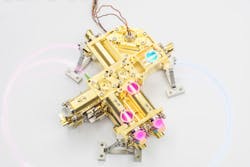Space-borne quantum photon source to secure communication
A small, rugged quantum photon source created by researchers at the Fraunhofer Institute for Applied Optics and Precision Engineering IOF (Jena, Germany) has, in testing, been made to endure leaps in temperatures from -40 to +60 °C, exposure to cold and heat in vacuum, and jarring rides on a triple-axis vibrating platform. Throughout this campaign, the device had to demonstrate unwavering robustness and high performance. When this quantum source passed the last of a battery of stress tests conducted to the European Space Agency’s stringent standards, it was deemed spaceworthy.
The quantum source can generate 300,000 entangled photon pairs per second as laser light hits a nonlinear crystal. The twinned photon enable sensitive messages to be securely encrypted. The two photons’ polarization remains entangled (correlated) no matter how far apart they may be, allowing two communicating parties to produce and share keys and immediately detect if a third-party attempts to intercept their communication.
But why does the quantum source have to be in space? Entangled photons could also be transmitted via fiber optic cables—however, this shortens the range of photon entanglement. A better option is to piggyback the quantum source on a satellite and send it into low-Earth orbit, where it can transmit the twinned photons down from an altitude of 400 km with minimal disturbance.
"The quantum source's stability and performance presented the greatest challenges because the loss rate is still high on the way through the Earth’s atmosphere. This is why it is so important to generate as many entangled twin photons as possible to maximize the number of photons that reach the communicating parties on Earth," says Fraunhofer IOF project manager Oliver de Vries. One key always requires several pairs of photons. Explaining this, de Vries says, "We optimized the quantum source’s stability with a smart design, effective inorganic bonding processes, and robust materials that do not expand much in the event of temperature changes."
The technology is attracting attention, particularly from banks and government agencies that rely on secure communication. However, the infrastructure needed to share keys has yet to be established before quantum encryption can be implemented in three to five years' time. The communicating parties would have to receive the photons with a telescope, which would have to be integrated into the IT structure.
De Vries already has a plan in mind. "I could imagine a business model where Fraunhofer equips the satellite with a quantum source and outside partners offer the reception infrastructure and sell the keys," he says. The research team's goal is to send the first European quantum satellite into space in around four years.
About the Author
John Wallace
Senior Technical Editor (1998-2022)
John Wallace was with Laser Focus World for nearly 25 years, retiring in late June 2022. He obtained a bachelor's degree in mechanical engineering and physics at Rutgers University and a master's in optical engineering at the University of Rochester. Before becoming an editor, John worked as an engineer at RCA, Exxon, Eastman Kodak, and GCA Corporation.

